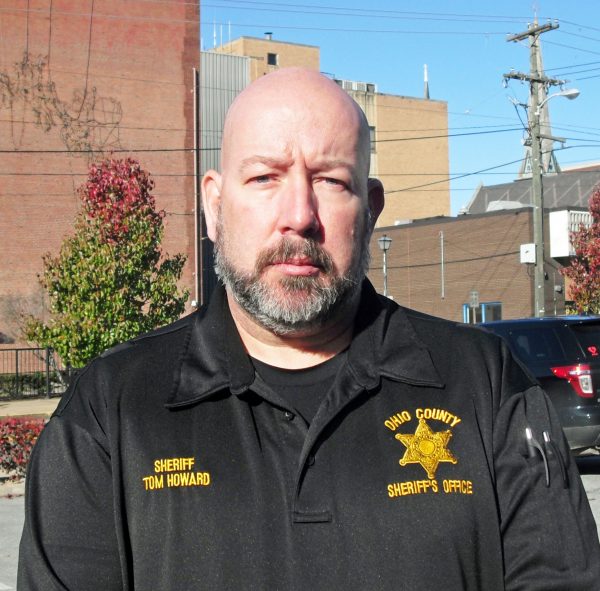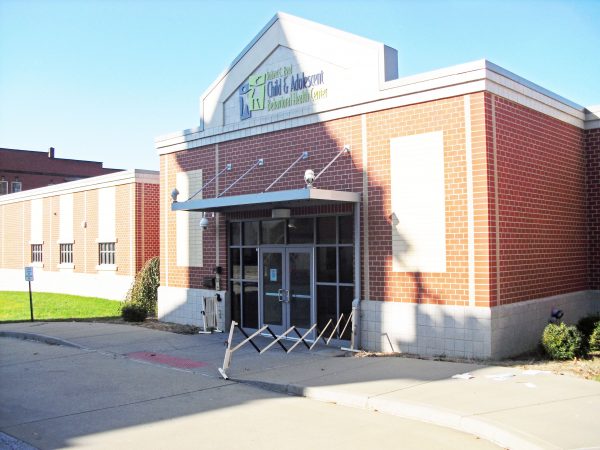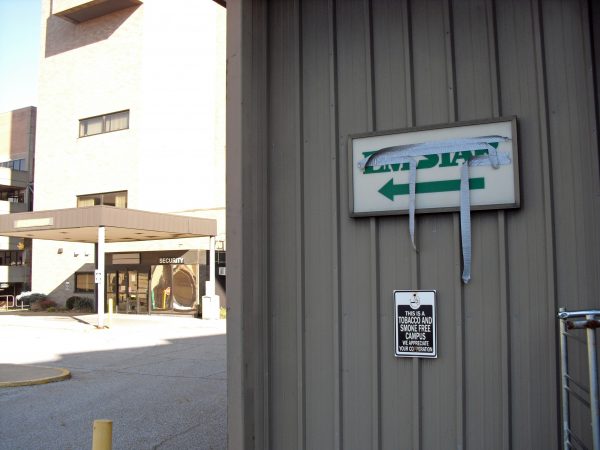Editor’s note: As part of ongoing coverage of the fallout from regional hospital closures, Weelunk looks today at what is happening to some of the most vulnerable patients who used to come through the doors at Ohio Valley Medical Center — mentally ill individuals who are suicidal or potentially dangerous to others and are under court-ordered care.
What hospitals, private practices and treatment centers that remain in the Wheeling area can handle your broken leg or your heart attack. Your addiction, panic attacks or even deep depression are also covered.But, should an acute episode of mental illness bring you or someone you love to the brink of suicide or violence anytime soon, you might be traveling as far away as the Virginia border to get help.
It is already happening — an average of one time a day.

Since the closure of inpatient psychiatric facilities operated by the former Ohio Valley Medical Center in early September, about 60 Ohio County adults have been transported to hospitals in Fairmont, Huntington, Princeton and elsewhere in the state.
These individuals — who have been involuntarily committed to inpatient psychiatric care by the courts because of behavior that is dangerous to self or others — have nowhere else to go since the closure of the former OVMC’s Hillcrest center.
“We don’t have a close facility now,” said Dr. Perry Stanley, licensed psychologist and clinical director of Northwood Health Systems. That outpatient facility is state mandated to handle the medical side of involuntary commitments for Ohio, Marshall and Wetzel counties.
“(People are being taken) a couple hundred miles from family and friends,” Stanley said. “There are no other options … and, there’s no holding place (while individuals are waiting to be transported elsewhere).”
Stanley said a patchwork system that includes set-aside ER space at Wheeling Hospital, twice-daily mental hygiene hearings, and sheriff’s deputies driving the involuntary commitments to locations as remote as Princeton is holding together for now.
But the overtime and stress overload required by everyone from police to licensed psychologists has key players wondering how long that will be the case.

“My guys are really worn down,” said Tom Howard, Ohio County sheriff, of staffing the new normal. This sometimes requires two deputies and as much as 32 hours of custodial supervision per involuntary commitment.
That kind of officer time means Howard is also out of money, with overtime funds nearly exhausted just a few months into the fiscal year. The governor has discussed the possibility of the state offering an assist, Howard said, but no details on how or when have been forthcoming.
At Northwood Health Systems, Stanley said the situation is similar in terms of overtaxing staff. But there is another, perhaps even more grim factor in play.
Stanley is concerned about not only the adult patients, but juveniles. The Robert C. Byrd Child and Adolescent Behavioral Health Center — the only youth inpatient facility in the region — was also shuttered in the OVMC closure.
“We have young people who are alleged to be a danger to themselves or others, and we don’t have a place to put them,” Stanley said.
“All we can do is make a recommendation,” he explained, noting state law does not allow involuntary commitment of juveniles.
Stanley said some parents are seeking inpatient treatment for their children in other, sometimes far-flung, cities. Others are simply taking their children home, hoping outpatient treatment will suffice.
“That (going home) may work very well for some,” Stanley said. “But for others, it could put that young person at risk.”

WHAT WAS WORKING THEN
Prior to the closure of the adult and juvenile psychiatric facilities, both Howard and Stanley said the overall OVMC system was working well when it came to handling such cases.
Stanley summarized how it used to be:
A person experiencing an extreme episode of mental illness could voluntarily come in or be brought in by friends or family through EMSTAR, the OVMC emergency room. There, the individual was assessed and, if necessary, admitted to the age-appropriate psychiatric facility.
Or, if police suspected an adult to be a danger to himself or others — often based on reports from friends or family — they could pick the person up, take him into non-criminal custody and drop him off at EMSTAR. That would launch a potential involuntary commitment, and the sheriff’s deputies involved would be on their way to other duties.
“It was a pretty direct transfer from the emergency room up to the second or third floor to what was Hillcrest,” Stanley said.
It was also a relatively comfortable one.
On the involuntary side, psychologists had 24 hours to set up a mental hygiene hearing for a court official to determine the need or lack of need for a commitment, Stanley said. Until the hearing, the individual could be housed, fed and protected from harm at Hillcrest, which was set up to house even combative individuals.
If a commitment was ordered, the individual remained at Hillcrest. Or in rare cases (about 5 percent, according to Sheriff Howard), was transported to another facility.
Juveniles had a similar system. While they could not (and still cannot) be involuntarily committed by state law, parents could voluntarily commit them for short-term care at the RCB center until the dangerous episode passed.

WHAT’S NOT WORKING NOW
Now, there is no set place to go and a learning curve that cannot be ignored, Sheriff Howard said.
“No!” is what he told Wheeling Hospital staff unaccustomed to such cases when it was suggested involuntary commitments coming through that ER be handcuffed.
“They are not in criminal custody. They’re in custody so we can protect them,” Howard said. “They’re already having some kind of an issue going on, we don’t want to make it worse. We need to be humane.”
Acknowledging a few individuals have become combative to the point of needing bed-based restraint while at Wheeling Hospital, he said most of the post-OVMC involuntary commitments have involved long hours waiting for a psychiatric bed to be found somewhere in the state.
While they wait, the involuntary commitment and a deputy (or two deputies if an individual is combative) effectively camp out at Wheeling Hospital’s ER, Howard said. That’s the only local place where there’s a bed for sleeping and food service.
To help speed the process somewhat, Northwood and the county mental hygiene commissioner are now conducting two hearings a day instead of one, Stanley said.
If an involuntary commitment is ordered, “Northwood staff has to find a bed somewhere in the state,” he noted. “There has to be a hospital in West Virginia. We can’t take them over the river (per state law).”
In spite of these efforts, Howard said, one commitment can take up to 32 hours of deputy time. In early November, for example, a series of three commitments began on a Tuesday evening and did not wrap up until early Thursday morning. Those individuals wound up going to hospitals in Huntington and Fairmont.
“It’s already paid for itself,” Howard said of an unmarked transport van that was serendipitously purchased before the OVMC closure. It gets more than 40 miles to the gallon. Plus, its size allows two deputies (required for safety) and up to four involuntary commitments (assuming non-combativeness) to travel together if needed.
But the hours are long, van or no van, he added. Just the driving time to and from Princeton is 10 hours. And, if there are follow-up hearings — which can happen mid-hospitalization — that means returning the involuntary commitment back to Wheeling, perhaps only to return them to a far-flung city the same day if they are not released.

HOPING FOR CHANGE
Both Stanley and Howard are hopeful that change is in the works — and that state officials will tweak some laws if necessary to make that change come quickly.
One example? West Virginia University Medicine, which now operates Wheeling Hospital as well as Reynolds Memorial Hospital in Marshall County, has already discussed opening inpatient psychiatric units locally.
(A spokesperson for Wheeling Hospital confirmed such discussion remains in the works, but declined to update that possibility for this posting.)
Realizing it can take months to get Certificates of Need for new services from the state Health Care Authority, Howard is hoping the state will do something to fast track the process.
There are also laws that could be tweaked, he said, including the one that mandates involuntary commitments as solely the responsibility of each county’s sheriff’s department. He would like to see all police departments share some of the custodial and transport burden, at least in the short term.
Howard would also like to see that state-promised cash to replenish his empty overtime budget. A presidential visit to the county and two months of post-OVMC duty have wiped it out.
Stanley, who noted that the kind of lockdown units needed for involuntary commitments will also take construction time, would like to see existing facilities considered.
He said, specifically, he has not heard even a whisper about anyone opening an inpatient center for youth locally.
“I can look out my (Northwood office) window and see the Robert C. Byrd center, which is lovely,” Stanley said. “(But) it’s empty, and a need’s not being met.”
• A long-time journalist, Nora Edinger also blogs at noraedinger.com and Facebook and writes books. Her Christian chick lit and faith-related non-fiction are available on Amazon. She lives in Wheeling, where she is part of a three-generation, two-species household.


